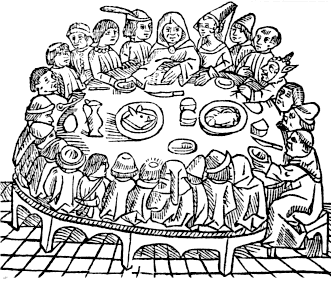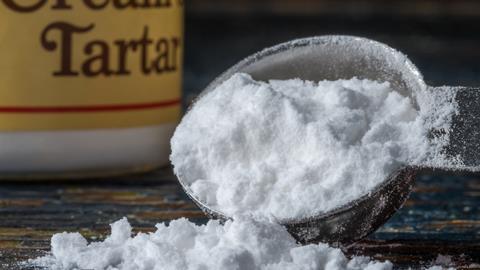Ben Valsler
Check your kitchen cupboards – there’s a chance you may have a tub of this week’s compound lingering somewhere. Here’s Brian Clegg.
Brian Clegg
Potassium bitartrate, also known as potassium hydrogen tartrate, is a compound once found in many kitchens under the guise of cream of tartar, which has possibly the most delightful origins of any substance. It is a waste product from the winemaking industry, just as yeast extracts such as Marmite are unwanted by-products of beermaking.

Our subject is a salt of tartaric acid. A simple carboxylic acid – one with the carboxyl group C=O-O-H – tartaric acid forms naturally in plants, reaching wine via the grape and crystallising out in the form of potassium bitartrate. This mostly occurs in the manufacturing process, though it’s not uncommon to find the crystals on the cork or in the bottom of a wine bottle.

The whole process of producing this clear crystal is littered with exotic naming. When the crystals are deposited on the inside of wine barrels they are known as argol or argal, a word that dates back to the thirteenth century. After the crystals are harvested they become known as beeswing, named for the formation of very fine films of potassium bitartrate on port, resembling near-transparent insect wings.
And that traditional name ‘cream of tartar’ for the purified, white crystals again is something of a mystery. It has been suggested that the name is of Arabic origin, but there is some evidence that the Arabic term was borrowed from European use. It was certainly already widespread in Chaucer’s time, who refers to it (and argol) in the Canon’s Yeoman’s Tale, which refers to ‘Cley maad with hors or mannes heer, and oille of tartre, alum glas, berme, wort, and argoille.’ The tartar that builds up on teeth is probably named because it is a deposit in the same way that bitartrate forms on wine barrels, but is chemically unrelated.

The most common way potassium bitartrate still creeps into our kitchens is as one of the ingredients of baking powder. This is a simple mix of sodium bicarbonate and an acid salt, with potassium bitartrate traditionally fulfilling the role, though modern baking powder often contains more industrially produced phosphate-based acid salts. When added to dough or batter, the acid and alkaline components react and give off carbon dioxide, bubbles of which lighten and lift the mixture.
However, this was only one of the reasons that cream of tartar would regularly be found in traditional kitchens and why the compound can still turn up in large scale food making. It helps stops powders caking – which is to say getting lumpy – keeps both egg whites and whipped cream from collapsing, making for more impressive meringues, and can even help prevent boiled vegetables from losing their natural colour.
Another reason cream of tartar would have been popular in a Victorian kitchen would be to help with the cleaning, a role that is seeing a resurgence with the growth of interest in environmentally benign cleaning products. Mixed with water it can be used on bathrooms and other similar applications, while in a mildly abrasive paste made up with lemon juice or clear vinegar it can be substituted for more aggressive metal cleaning products and to get ink stains out of clothing. Inevitably there is a balance to be struck: the stronger commercially available products will clean better, but for those who are concerned about their environmental impact, the benefits are clear.
Although household use had dropped until the recent rise in interest in natural products, chemists have maintained a very specific application of potassium tartrate as a pH buffer. The role of a pH buffer, which typically consists of a mix of a weak acid and alkali, is to prevent the level of acidity in a solution from varying. In blood, for example, carbonic acid and carbonate ions keep the plasma at a tightly controlled pH. A saturated potassium bitartrate solution is used as a reference buffer by the American National Institute of Standards and Technology.
Cream of tartar sounds like the kind of substance your great-grandmother would have used at home – and it probably was. But with the growth in interest in low environmental impact cleaners, the simple compound potassium bitartrate could see a domestic resurgence. Not bad for a mere waste product of wine making.
Ben Valsler
So even if you don’t have any potassium bitartrate in your kitchen cupboards, there’s a chance that you may have a bottle of the wine from which it is a byproduct. That was Brian Clegg. Next time we continue catching compounds in kitchen cupboards, with Jamie Durrani.
Jamie Durrani
But it’s this balance that makes peppercorns perfect for flavouring gins and brandies, as well as livening up your spag bol – it’s no wonder that black pepper has been the world’s most traded spice for thousands of years!
Ben Valsler
So pick up a podcast about piperine from peppercorns next week. Until then, get in touch with any ideas for compounds to cover – perhaps there’s something lurking in your larder that you would like to know more about? Email chemistryworld@rsc.org or tweet @chemistryworld. I’m Ben Valsler, thanks for listening.













No comments yet